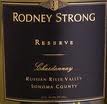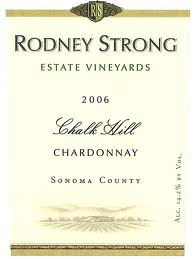(Robert Whitley’s Creators Syndicate column this week.)
I caught up this week with Rick Sayre, the longtime winemaker at Rodney Strong Vineyards, the venerable winery that almost single-handedly introduced the Chardonnay grape to Sonoma County. At least that’s how it was in the telling by the late Rod Strong, who had been a veteran of vaudeville and remained a flamboyant character until the very end.
 Sayre’s tenure speaks volumes about the winery and its footprint in the California wine industry. He’s been there 31 years, through good times and bad. His legacy, to the extent the modest and soft-spoken Sayre might consider his legacy, would be consistency.
Sayre’s tenure speaks volumes about the winery and its footprint in the California wine industry. He’s been there 31 years, through good times and bad. His legacy, to the extent the modest and soft-spoken Sayre might consider his legacy, would be consistency.
He was there on the front lines when Tom Klein purchased the winery in 1989 and infused it with much-needed cash to purchase better equipment and choice vineyards in the Russian River and Alexander Valleys.
"I’ve always said you can have all the tricks in your bag, but first you have to start with good grapes," Sayre said over lunch at a San Diego restaurant.
He is still there after more than two decades of growth and a trail of stellar wines that few could have imagined a quarter-century ago. Prior to the arrival of the Klein family, RSV’s claim to fame had been its ubiquitous Sonoma County Chardonnay, an inexpensive Chardonnay that was among those that had been dubbed "fighting varietals" at a time when the very existence of "varietal" wines in California was a novel concept.
They were called "fighting" because of the low price point, which was intended to make them competitive with Jess Jackson’s new and wildly popular (at the time) Kendall-Jackson Vintner’s Reserve Chardonnay.
 Rodney Strong is still a major player in the "value" category, producing more than 700,000 cases annually of dependable Sonoma County Cabernet Sauvignon, Chardonnay, Zinfandel, Merlot and assorted other wines that retail between $13 and $17. That’s what pays the bills and makes the more upscale Rodney Strong wines possible. The upscale wines would be the other face of Rodney Strong Vineyards, the side that is too often overlooked.
Rodney Strong is still a major player in the "value" category, producing more than 700,000 cases annually of dependable Sonoma County Cabernet Sauvignon, Chardonnay, Zinfandel, Merlot and assorted other wines that retail between $13 and $17. That’s what pays the bills and makes the more upscale Rodney Strong wines possible. The upscale wines would be the other face of Rodney Strong Vineyards, the side that is too often overlooked.
I would argue that even these more expensive Rodney Strong wines represent value within the context of quality and the going rate for the competition. At the top of the heap is the sensuous Symmetry (the winery also has a line of highly stylized proprietary wines that won’t be discussed here) red Bordeaux blend.
I still have a number of bottles of Symmetry from the 1990s in my cellar, and they never disappoint when I open one. The current vintage is 2007, which was a cool year in Sonoma County. It retails for $55 and exhibits layered black and red fruit aromas, notes of mocha and spice, and beautifully integrated tannins, which are smooth and supple and lend a seductive texture on the palate. The stated alcohol is a bit high at 15.1 percent, though there is no noticeable heat on the finish. Other wines of its ilk would start at about $75 a bottle.
But the real bargain in Rodney Strong reds is the Russian River Valley Pinot Noir at $20. I tasted the 2009, and the first thing that impressed me was the gorgeous nose, a complex array of floral, earth and berry aromas.
Although light crimson in color, it didn’t lack for flavor or texture on the palate, and the finish was long and inviting. As in "have another glass." Pinot of this quality usually comes from the $35 range.
 I also evaluated three whites: 2008 Reserve Chardonnay ($35), 2009 Chalk Hill Estate Chardonnay ($20) and 2009 Charlotte’s Home Sauvignon Blanc ($13.50).
I also evaluated three whites: 2008 Reserve Chardonnay ($35), 2009 Chalk Hill Estate Chardonnay ($20) and 2009 Charlotte’s Home Sauvignon Blanc ($13.50).
The Reserve Chard is voluptuous and rich, with a spicy note of wood that complements the ripe pear flavor profile. There is a subtle hint of lemon creme, and bright acidity that knifes through the oily texture of this wine. It’s utterly delicious.
The Chalk Hill Chardonnay is leaner with more apparent acidity, but it also has lovely pear, apple and citrus aromas.
The Charlotte’s Home Sauvignon, which has long been one of my favorites from Rodney Strong, is a steal at the price. Grapes are sourced from the cool Russian River Valley and the warm Alexander Valley, contributing to the complex palate of citrus, gooseberry and tropical fruit aromas.
8
